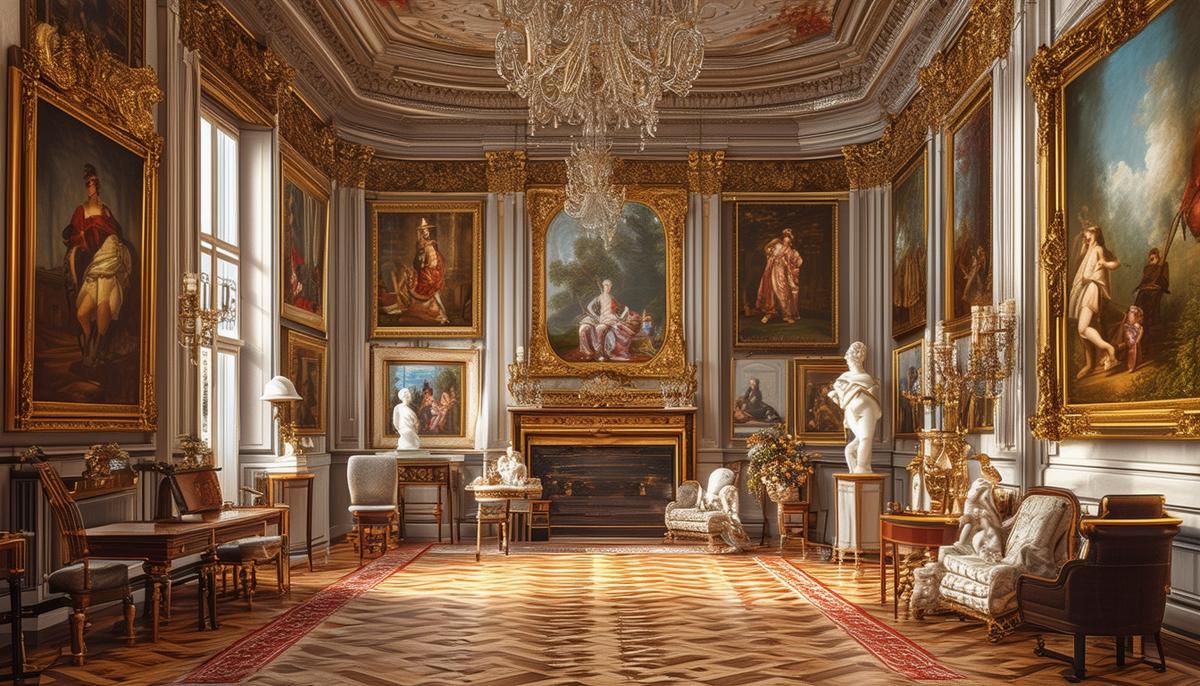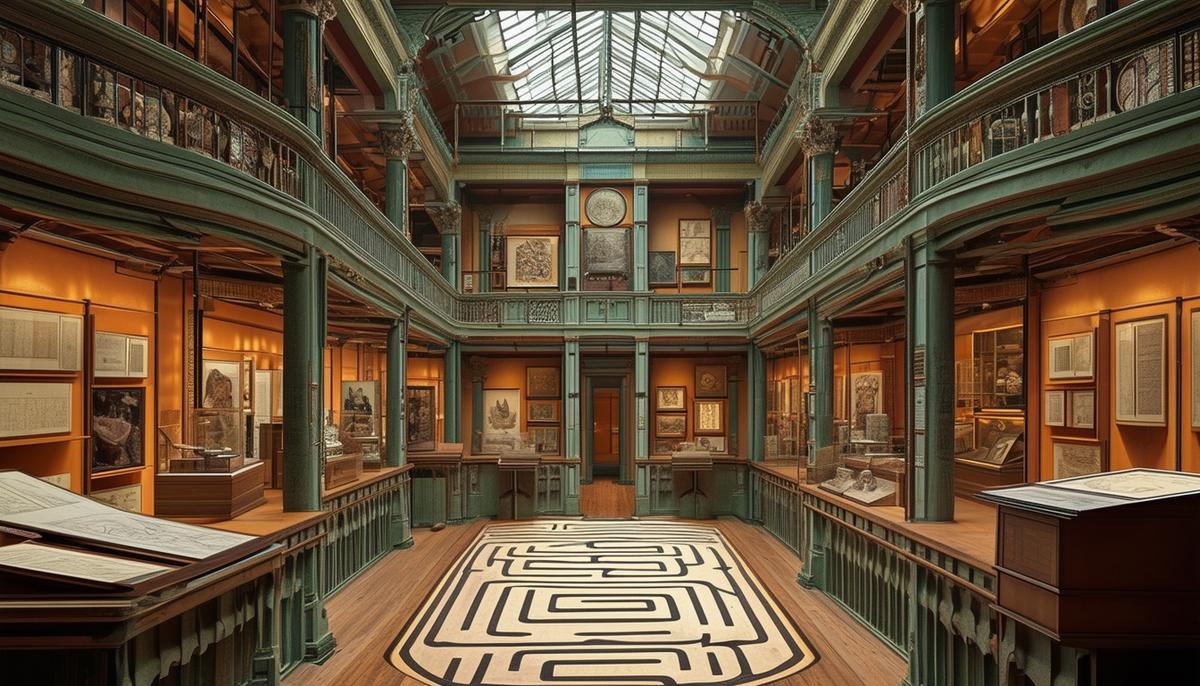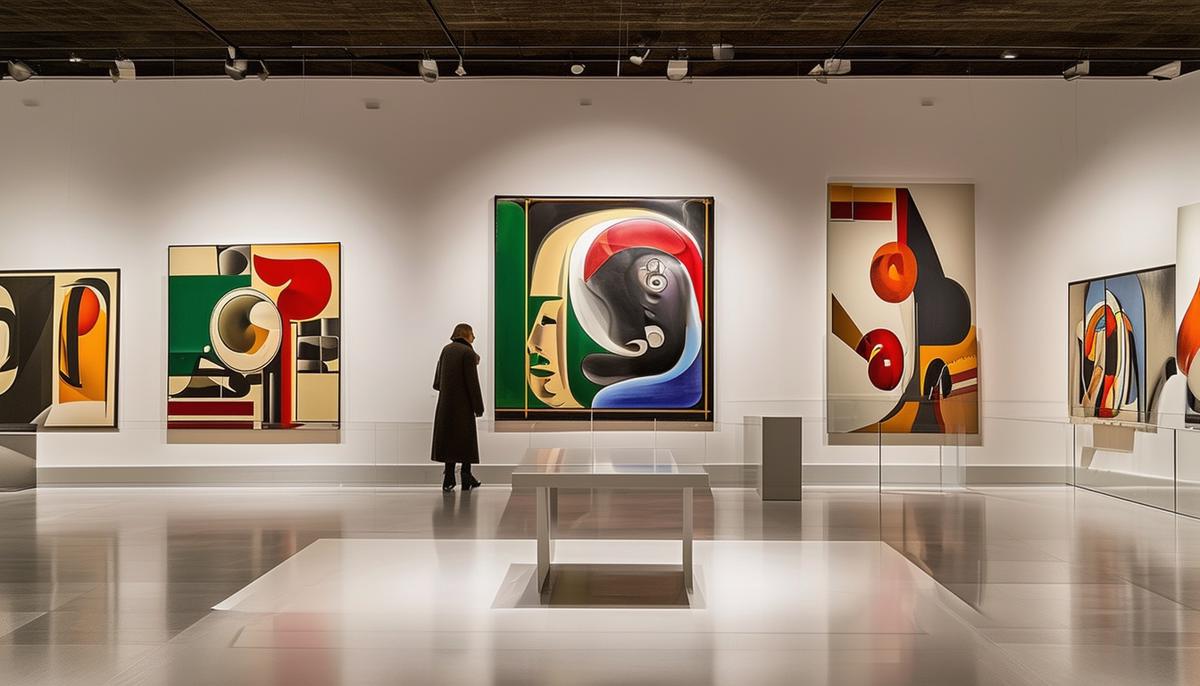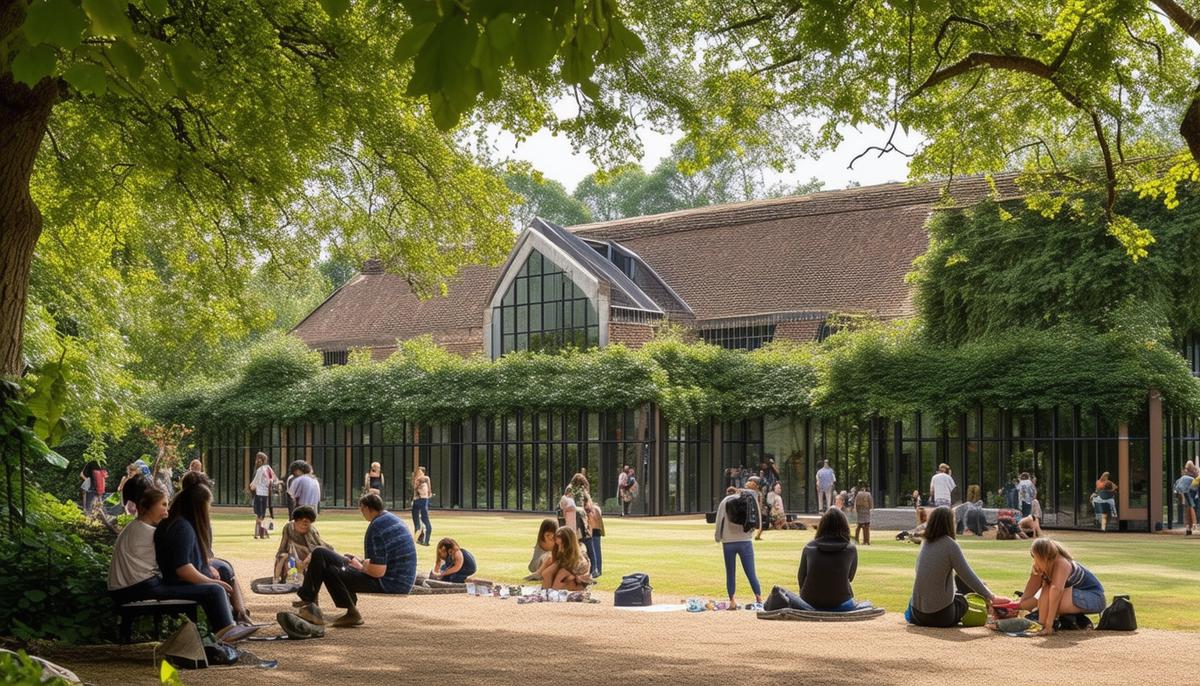Wallace Collection
Housed in the grandeur of Hertford House, Marylebone, the Wallace Collection stands as an exemplary shrine to 18th-century French artistry. This luxurious domicile not only serves as a safe harbor for paintings but also encompasses an intriguing range of decorative arts, including wieldy furniture pieces and sculptural marvels. Crowned by Wizz Air as the world's foremost hidden tourist gem, it acknowledges the gallery's measured blend of cultural profundity and artistic allure. Strategically located a mere skip from the commercial humdrum of Oxford Street, its physical prominence belies its metaphorical camouflage amidst the urban fray.
The Collection's well-earned tribute leans heavily on more than just historic gravitas or aesthetic abundance. Beneath the surface, it's the story of each artifact, each canvas that whispers the erstwhile echoes of European corridors of power, their dalliances, and dramas. Peer closely, and find yourself immersed in a Versailles-esque saga, with artists such as Velázquez, Gainsborough, and Titian animating the narratives through their timeless brushstrokes.
Each room within the Collection speaks of the opulent ambiance once prevalent in these spaces. The intended impact is unambiguous—the thrill of an esoteric encounter with art that transcends mere visual pleasure, wading into the depths of shared human heritage and insightful elucidation of sophisticated histories. The aura breezes through the arches of Hertford House, presenting an interplay sanctioned by centuries of careful preservation and passionate collecting.
Visitors who thread through the Gallery's corridors encounter more than just a museum; they experience an intersection between an art archive and a latent rendezvous with history's silent witnesses. Commanding absence in many travel guides preserves an atmosphere where the intimacy of encounter remains unspoiled by throngs; where every artwork can be savored without the jostling crowds, linking each viewer with the patrons and artists of yore in undisturbed communion.
The Wallace Collection isn't merely observed; it's profoundly felt, intimately experienced—a masterclass in understatement standing resolute amid London's ceaseless timbre.

Sir John Soane's Museum
Nestled within the historic precinct of Lincoln's Inn Fields, Sir John Soane's Museum offers a deeply personal glimpse into the eclectic mind of Sir John Soane, one of Britain's most innovative architects. With its labyrinth-like hallways and ingeniously designed spaces, the museum itself stands as a testament to Soane's genius in manipulating light and space—a core element that accentuates the myriad artefacts housed within.
Envisaged and curated by Sir John Soane himself, the museum is a mélange of architectural trial-runs, personal collections, and an insightful narrative into his creative journey. Each alcove, corner, and corridor tells a story—be it through eerie crypts housing Egyptian antiquities or cabinets filled with architectural models and drawings that spark the intrigue of both enthusiasts and novices.
Among the historical treasure trove, one encounters awe-inspiring artefacts ranging from ancient Greek and Roman statuary to neo-classical works by Canova. These pieces echo the grand narratives of western culture and weave into the very framework of the house, blurring the lines between dwelling and museum, private fascination and public offering.
Soane's personal history as a rags-to-riches architect is mirrored in every corner of the museum. His knack for creating perspectives and vistas across rooms filled with paintings and sculptures turns the museum experience into an almost theatrical manifestation of his life's work. It's as if the visitor walks through the chambers of his imaginative intellect, deciphering visual dialogues between assorted pieces cleverly positioned throughout.
The museum's Dome Area is particularly mesmerising, where layers of artworks are visible through apertures that afford views from one part of the museum to another—ancient meets modern in sightlines that punctuate Soane's mastery of interior exhibition. Natural light ingeniously passes through skylights and reflective surfaces to illuminate works that might otherwise remain shrouded.
The celebrated sarcophagus of Pharaoh Seti I, ensconced within the Sepulchral Chamber, rests as a centrepiece, indicative of Soane's passion for antiquity and his foresight in preserving such wonders within an urban dwelling. This juxtaposition of mortality and eternity resonates deeply, offering poignant reflections on themes recurrent in Soane's architectural philosophy which embraced enlightenment ideals.
Sir John Soane's Museum serves as a profound archetype of personal collection as public legacy. The dense array of artefacts, paired with Soane's innovative design techniques, renders it a veritable cabinet of curiosities which demands exploration. For those endeared to the marriage of architectural brilliance and eclectic historic artistry, the museum is an intimate environment culminating in an intellectual feast, bidding visitors explore the depths beneath its unassuming facade. In exploring Soane's sanctuary of art and architecture, one pieces together the sublime narrative of a visionary and his undying love for broadened horizons within the confines of his own creation.

Lesser-known Artistic Spaces
Tucked away in the serene environs of Canonbury Square, Islington, the Estorick Collection of Modern Italian Art provides a distinct narrative sharply cut from the well-trodden paths populated by London's larger art institutes. A Georgian Grade II listed façade welcomes visitors into the homely environs which, despite its modest scale, unfurls an enviable collection predominantly focused on Futuristic and modern Italian masterpieces.
Founded in 1998 from Eric Estorick's personal collection, the gallery showcases an array of seminal works that trace the explosive creativity of the Futurist movement—a trail marked by dynamism and an uproar against traditional artistic norms. Iconic pieces from the likes of Giacomo Balla, Amedeo Modigliani, and Umberto Boccioni serve both as individual splendours and collective chronicles tied intricately under the banner of Italian modernism. The Estorick's sparse, intimate setting aids a disarming encounter with the fervour and movement expressed by these modern framings, free from the overwhelming sprawls characteristic of larger galleries.
The Guildhall Art Gallery, planted stones-throw from the bustling paces of Bank and Moorgate in central London, houses around 4,000 works that narrate 400 years of London's robust and tempestuous tale. Recovered and reopened in 1999 after being ablaze during the Blitz, and subsequently reconstructed over remnants of a Roman amphitheatre, the Gallery stages an absorbing blend of displays from pre-Raphaelite treasures to more vernacular imaging by lesser-known painters. The layered presentation brings to bear a direct line to London's dramatic societal oscillations and yokes them to the quandaries central to our human conditions—honour, tragedy, adversity.
Beneath this idyllic scenario disinterred during refurbishments, lies the vestigial structure of London's Roman amphitheatre. Its ancient masonry laid bare offers a literal and metaphoric ground cultivating deeper connectivities with the city's past. The Gallery's rotating schedule often spotlights thematic eclectic exhibitions that make brilliant use of their historical artefacts juxtaposed with contemporary interpretations, keeping the narrative ever compelling.
These galleries distinguish themselves as spaces offering layered cultural dialogues with their visitors—each painting, sculpture, and historical relic stands as testaments to eclectic momentums pushing past narrative and geographical confines. Where ubiquitous establishments boast grandeur, these lesser-noted spaces flex the unique potency embedded in quieter contemplation and the personalised pollination of art's historical and aesthetic plethoras. Each visit here allows traditions and epochs to whisper spirited odes to their enigmatic heritages—an intangible collection arguably as priceless as the artworks they house. For those enthralled by bastions of culture cosseted away in the nooks of otherwise relentless metropolises, such galleries provide essential keys proffering admission into layered depths of both London's and Italy's effervescent art histories.

Impact of Hidden Art Gems on Local Culture
In the suburban tranquillity of South London, Dulwich Picture Gallery, ensconced within its own leafy demesne, champions an illustrious bequest of Old Masters and vibrantly echoes the cultural pulse of its vicinity. As England's first purpose-built public art gallery1, its architectural sanctity and the subsequent curation philosophies have firmly embedded it within the local cultural narrative, shaping and being shaped by community identity over centuries.
Dulwich Picture Gallery has always transcended the conventional role of an art repository—its ethos being interaction rather than mere transaction. The gallery's engagement programs serve as crucibles where community rapport simmers via creative activities. From artist-led workshops for locals to special group visits for schools, there is a prolonged commitment to invoking local participation and ensuring the art reverberates beyond the gilded frames to influence daily lives.
The enduring tradition of volunteering at the gallery taps into the community's vein of readiness to involve and contribute, enhancing a shared stewardship over this cultural landmark. These gestures foster a feeling of belonging, storied ties that delineate and nurture local identity and a sense of continuity amidst rapid urban evolution.
The William Morris Gallery in Walthamstow engages a deeper stratum of cultural impact, sparkling as much more than a mere showroom of Morris's aesthetic and philosophical operatics. Set in a grand house where William Morris once lived2, it now encapsulates a geo-cultural emblem, greatly influencing the landscape of local and artistic commerce and awareness.
Morris's espousal of design and social paradigms introduces thought-footprints that thread into the fabric of contemporary engagement—his ideals about beauty intertwined with utility and access choreograph a cultural ballet observed in local crafts fairs, educational programmes, and more profoundly, in the area's evolving artistic inclinations. The gallery acts as a guardian of his imprints and fans the echoes further into schooling curriculums and aesthetic tastes pervading northeast London.
The gallery kindles continuous interactive fare with the community through exhibitions that do more than occupy visual wonder. They deliberate on connecting past with present policymaking — envisaging futures informally scribed on the palimpsests of Morris's ideologies. Beyond admiration and learning, these engagements create an ongoing dialogue regarding environment, artistry, and civic nucleus harmonised through shared heritages—configuring a bastion of cultural resilience etched significantly deeper than its artefactual allure.
Throughout their existence, both Dulwich Picture Gallery and the William Morris Gallery are not static institutions or islands within their environs; rather, they act as pulsating hearts of local culture and confluence. In their quietude lies a resonant stature—on gala days filled with fecund conversations, dusks relegated to sagas immortalised in the cadre resurrected through varied interpretations and vent by local voices. These art centres become auxiliary in orchestrating strands of continuity—intonating reflections and creating habits, cultural spontaneities bonded by heritage, thus grafting sublime dimensions of familiarity and identity across timeline iterations—to which locals return as they piece their culture, progressively sewn anew.

In essence, the Wallace Collection and Sir John Soane's Museum serve as custodians of history and vibrant conduits for cultural discourse. They offer a sanctuary where art transcends time, inviting each visitor to partake in a continuum of artistic legacy. This profound interaction between viewer and artefact imbues these spaces with an enduring relevance, firmly anchoring them in both the landscape of London and in the hearts of those who walk their hallowed halls.
- Bryant J. Dulwich Picture Gallery: An Introduction. London, England: Scala Books; 2013.
- Harvey C, Press J. William Morris: Design and Enterprise in Victorian Britain. Manchester, England: Manchester University Press; 1991.























